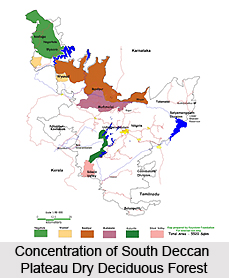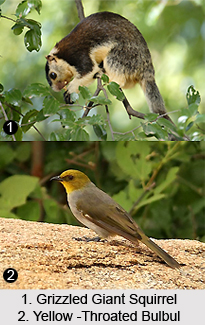 The South Deccan Plateau dry deciduous forests in India are located adjacent to the moist deciduous forests that lie along the foothills of the southern extent of the Western Ghats Mountains. Though the forests are not exceptionally rich in biological diversity or endemism, they are home to numerous flora and fauna species. The forests are included in those three ecoregions through which two of India`s most important Elephant conservation areas, the Nilgiris-Eastern Ghats and the Anamalais-Nelliampathis; and two of the most important TCUs extend across.
The South Deccan Plateau dry deciduous forests in India are located adjacent to the moist deciduous forests that lie along the foothills of the southern extent of the Western Ghats Mountains. Though the forests are not exceptionally rich in biological diversity or endemism, they are home to numerous flora and fauna species. The forests are included in those three ecoregions through which two of India`s most important Elephant conservation areas, the Nilgiris-Eastern Ghats and the Anamalais-Nelliampathis; and two of the most important TCUs extend across.
The South Deccan Plateau dry deciduous forests in India form an ecoregion that represents a large area of tall, tropical dry forests in the southern Deccan Plateau, on the leeward side of the Western Ghats Mountain Range. The ecoregion extends across the southern Indian states of Karnataka and Tamil Nadu and covers the southern portion of Karnataka`s Malnad region, extending south into the Kongu Nadu region of eastern Tamil Nadu. It has its links to the ancient, southern circumpolar continent, Gondwanaland. Climate plays an important role and influences the natural vegetation in these forests. The tall Western Ghats Mountain Range intercepts the moisture in these forests from the southwest monsoon and as a result, the eastern slopes and the Deccan Plateau receive very little rainfall. The annual rainfall in these forests ranges from 900 to 1,500 mm and the rainfall is mainly caused by the southwest monsoon, during the months of June to September.
 The South Deccan Plateau dry deciduous forests in India are flanked by the moist deciduous forests along the lower elevations and foothills of the Western Ghats to the west. They are flanked by the thorn scrub to the east. In 1968, the forests were classified by Champion and Seth as Southern Dry Mixed Deciduous Forests, where Teak is not conspicuous. The thorny plants have become more common in some areas in the forests, where grazing pressure is high. The forests have a three-storied structure, with an upper canopy of 15-25 m, an understory of 10-15 m, and undergrowth of 3-5 m. The Lianas drape the trees in denser, mature forests.
The South Deccan Plateau dry deciduous forests in India are flanked by the moist deciduous forests along the lower elevations and foothills of the Western Ghats to the west. They are flanked by the thorn scrub to the east. In 1968, the forests were classified by Champion and Seth as Southern Dry Mixed Deciduous Forests, where Teak is not conspicuous. The thorny plants have become more common in some areas in the forests, where grazing pressure is high. The forests have a three-storied structure, with an upper canopy of 15-25 m, an understory of 10-15 m, and undergrowth of 3-5 m. The Lianas drape the trees in denser, mature forests.
The natural vegetation in the South Deccan Plateau dry deciduous forests in India is characterised by the species like Boswellia serrata, Anogeissus latifolia, Acacia catechu, Terminalia tomentosa, Terminalia paniculata, Terminalia belirica, Chloroxylon swietenia, Albizzia amara, Cassia fistula, Hardwickia binata, Dalbergia latifolia, Sterospermum personatum, Pterocarpus marsupium, Diospyros montana, and Shorea talura, etc. Sandalwood is one of the most important species found in these forests and it has been selectively removed from most of the forests in this ecoregion. In spite of not being high in endemism or diversity, the forests harbour several important populations of India`s large threatened vertebrates like the Elephants. Two high-priority TCUs named the Periyar-Kalakad and Dandeli-Bandipur overlap with parts of this ecoregion.
The South Deccan Plateau dry deciduous forests in India contain a rich variety of mammal fauna. The total number of mammal fauna species found in these forests is seventy-five and only one of them is considered as critically endangered. This species is the Salim Ali fruit Bat (IUCN 2000) and it is also considered as a near-endemic species. Some of the other threatened mammal species found in the forests include the Asian Elephant, Wild Dog, Sloth Bear, Chousingha, Gaur, and Grizzled Giant Squirrel. The forests are also home to a total of 260 bird species, out of which, two are considered as near-endemic species. These species are the Rufous Babbler and Yellow-Throated Bulbul and another two globally threatened species like the Indian Bustard and Lesser Florican are also found in these forests.



















